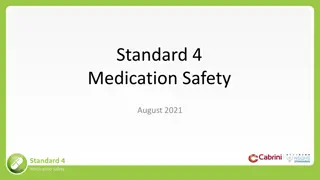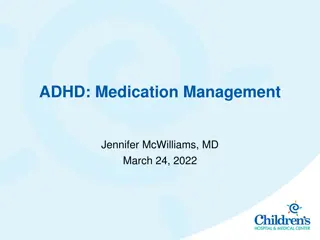Mastering Dimensional Analysis for Medication Calculations
Enhance your understanding of Dimensional Analysis (DA) for precise medication dosage calculations with a focus on its practical application in medication administration. Discover the benefits, importance of safety support, evidence supporting DA, and key conversions and abbreviations to remember for successful calculations. Learn the five essential steps for implementing DA effectively.
Download Presentation

Please find below an Image/Link to download the presentation.
The content on the website is provided AS IS for your information and personal use only. It may not be sold, licensed, or shared on other websites without obtaining consent from the author.If you encounter any issues during the download, it is possible that the publisher has removed the file from their server.
You are allowed to download the files provided on this website for personal or commercial use, subject to the condition that they are used lawfully. All files are the property of their respective owners.
The content on the website is provided AS IS for your information and personal use only. It may not be sold, licensed, or shared on other websites without obtaining consent from the author.
E N D
Presentation Transcript
DIMENSIONAL ANALYSIS AKA: FACTOR-LABEL METHOD
OBJECTIVES To increase knowledge of Dimensional Analysis (DA) for calculating medication dosages Demonstrate the application and usage of Dimensional Analysis (DA) during medication dosage calculation and medication administration
SAFETY SUPPORT FOR DA? The Quality and Safety Education for Nurses (QSEN) project goal is to minimize the risk of harm to patients through individual performance (Cronenwett et al., 2007) Teacher knowledge makes a substantial contribution to student achievement (Ball & Bass, 2003) A standardized approach to medication calculation can provide a solution to more than 1 in 6 medication errors (Lesar, Briceland, & Stein, 1997)
ADVANTAGES OF USING DA FOR MEDICATION CALCULATIONS DA is a consistent approach without memorizing formulas One step equations: no need for multiple equations No formulas needed Can be used for all problems and medications calculations Promotes critical thinking Use for simple or complex problems Supports problem solving and critical thinking Evidence supports the use of DA
EVIDENCE FOR DA Performance of the dimensional analysis method group as compared with the formula/ratio-and- proportion method group, indicated that the DA group performed statistically significantly higher (Serembus, 2000). DA used in chemistry, physics, and engineering While mistakes can still be made using any technique, DA does the best job of minimizing them. The only fault lies in the name. Perhaps the Math-Weenie No-Brainer Technique would be appropriate (Lee, 2006) .
CONVERSIONS AND ABBREVIATIONS TO REMEMBER 1,000 mcg = 1 mg gtt = drop mcg = microgram 1,000 mg = 1 g IM = intramuscular mg = milligram 1,000 g = 1 kg IV = intravenous g = gram 1, 000 ml = 1 L IVP = intravenous push ml = milliliter 2.2 lbs = 1 kg BID = twice a day 1 oz = 30 ml TID = three times a day oz = ounce gr1 = 60mg or 65 mg IVPB = intravenous piggyback 1 tsp = 5 ml PO = oral (by mouth) gr = grain 1 Tbsp = 15 ml L = liter tsp = teaspoon Tbsp = tablespoon
DIMENSIONAL ANALYSIS Five Steps for Dimensional Analysis 1. Identify the unit of measure desired in the calculation. Write the label for the answer on the right side of the equation. 2. Place the available information from the problem in fraction form on the left side of the equation. The abbreviation or unit matching the desired unit on the left side, must be placed in the numerator. 3. Enter conversion factors as fractions to work toward the desired label. (Equals over equals) 4. Cancel all labels that are in both the numerator and the denominator. 5. Do the math: multiply the numerators; multiply the denominators: then divide the numerator by the denominator.
CALCULATION FOR PEDIATRIC MEDICATIONS Safe dosage needs to be completed prior to administering pediatric medications. The following steps should be taken to do this: Pediatric medications are most commonly calculated based on body weight. The first step is to determine your patient s weight in kg (most formulas are based on kg). Safe dosage ranges are expressed in one of two ways: mg/kg/day in specific divided doses (2 step procedure) mg/kg/dose (1 step procedure) Now you can calculate the patient s safe dosage.
SAMPLE PROBLEM #1 A 280 pound man weighs how many kg? 1. 2. 1kg/2.2lb 3. 1kg/2.2lb X 280lb = 280kg/2.2 4. Answer = 127.2kg Answer sounds logical = kg X 280lb = 280kglb/2.2lb
SAMPLE PROBLEM #2 Order: Lasix (furosemide) 40mg PO daily Available: tablets labeled 20mg How many tablets will the nurse administer?
SAMPLE PROBLEM #3 Administer D5LR at 75 ml/h. The drop factor is 10 gtt/ml. Calculate the flow rate in gtt/min.
SAMPLE PROBLEM #4 Administer 1000 ml D5W in 6 hr. The drop factor is 15 gtts/ml. Calculate the flow rate in gtts/min.
SAMPLE PROBLEM #5 Infuse 200ml of NSS in 2 hr. The drop factor is 20gtt/ml. Calculate the flow rate in gtt/min.
SAMPLE PROBLEM #6 Order: Gentamicin (garamycin) 55 mg IM q8h. Available: Gentamicin (garamycin) 80 mg per 2 ml. How many ml will the nurse administer for one dose? How many ml will the nurse administer for one day?
SAMPLE PROBLEM #7 Ampicillin 750 mg IV q4h. Available: 2000mg per 5ml. How many ml will the nurse administer for one dose? How many ml will the nurse administer for one day?
SAMPLE PROBLEM #8 An IV of 500ml. NSS is to infuse at 60ml/hr. How long will the infusion take? If the IV was started at 2000 (chronological time; military time), when would the infusion be complete (state in chronological time; military time).
SAMPLE PROBLEM #9 Order: Gentamcin 50 mg IVPB q8h for a child weighing 40 lb. The recommended dosage for a child is 6 to 7.5 mg/kg/day divided q8h. Is the dosage ordered safe?
SAMPLE PROBLEM #10 Order: Phenobarbital 10 mg PO q12h is ordered for a child weighing 9 lb. The recommended maintenance dose is 3 to 5mg/kg/day q 12h. Is the dosage ordered safe?
RESOURCES Ball, D.L., & Bass, H. (2003). Toward a practice-based theory of mathematical knowledge for teaching. In Canadian mathematics education study group. Proceedings of the 2007 annual meeting of the Canadian mathematics education study group. Reston, VA: National Council of Teachers of Mathematics. Cronenwett, L., et al., (2007). Quality and safety education for nurses. Nursing Outlook, 55 (3)122-131. Lee, R.E. (2006). Medication math for the nursing student. Retrieved 6/12/2006 from: http://alysion.org/dimention/analysis.htm Lesar, T., Briceland, L., & Stein, D. (1997). Factors related to errors in medication prescribing. Journal of the American Medical Association , 277, 312-317. Serembus, J. (2000). Medication calculation ability of baccalaureate nursing students as a function of method of instruction. Widener University (doctoral dissertation).























